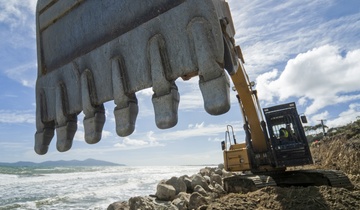Who should use the Toolbox?
The Toolbox is primarily designed for New Zealand city council staff with the following roles and responsibilities:
- infrastructure management
- asset management
- consents
- transport
- urban development
- strategic planning
- emergency management.
How is the Toolbox structured?
The central purpose of the Toolbox is as a fundamental reference for councils who are undertaking analyses of the potential effects of climate change on their city. It describes an end-to-end evaluation process of:
- understanding the issues
- assessing the likely hazard (or change in the hazard)
- identifying the risks
- evaluating options and their costs & benefits
- using the tools and improving practice.
The Toolbox structure follows these five stages of the evaluation process. Consistent with the "Toolbox" concept, each of these stages can be considered a "Tray" in the Toolbox. Users may choose to select Tools from any Tray, depending upon their information needs. Each Tool is a stand-alone document, designed to help the user with a specific task in the evaluation process. Some Tools provide information and guidance, while others describe models or approaches for estimating impacts and dealing with uncertainty. Wherever possible, worked-through examples are provided as well as critical sections on data needs, model assumptions and limitations.
Overview and Linkage Tools have been included throughout the Toolbox, to provide higher level summaries and "where-to-from-here" guidance, respectively. Furthermore, the authors of every Tool have been identified and can be contacted directly for more information, particularly regarding the use of models and other analytical methods.
Referencing the Toolbox
The following reference is suggested for this Toolbox:
- NIWA, MWH, GNS and BRANZ (2012) Impacts of Climate Change on Urban Infrastructure and the Built Environment: A Toolbox. Urban Impacts Toolbox
Individual tools within the Toolbox can be referenced by the corresponding authors and report titles, e.g. (note, the publication year for all tools is 2012) :
- Duncan, M. and Smart, G. (2012) Inundation modeling of present day and future floods, 13p. Tool 2.1.4 in NIWA, MWH, GNS and BRANZ (2012) Impacts of Climate Change on Urban Infrastructure and the Built Environment: A Toolbox. Urban Impacts Toolbox



